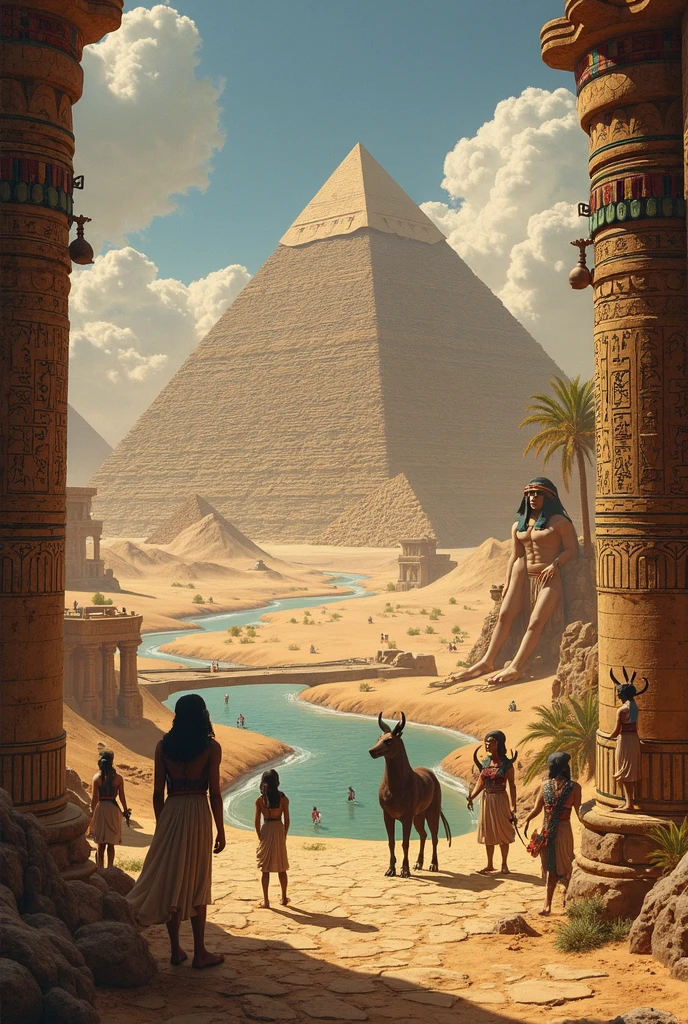Welsh Celtic Mythology: The Enchanting World of the Mabinogion
The rich tapestry of Welsh Celtic mythology is woven with tales of heroism, magic, and divine beings. At the heart of these legends lies the Mabinogion, a collection of medieval Welsh stories that have captivated readers for centuries. These tales, deeply rooted in the culture of Wales, feature iconic figures like Branwen, Arawn, and Taliesin, whose adventures reveal the spiritual and historical essence of the Celtic world.
The Mabinogion: A Treasure of Welsh Literature
The Mabinogion consists of eleven prose stories, compiled from medieval manuscripts such as the White Book of Rhydderch and the Red Book of Hergest. These texts preserve the oral traditions of the Celts, blending mythology, folklore, and history into a mesmerizing narrative. The tales are divided into four branches, each exploring different aspects of Welsh lore.
Key Branches of the Mabinogion
- Pwyll, Prince of Dyfed – Introduces Arawn, the king of the Otherworld.
- Branwen, Daughter of Llŷr – A tragic tale of war and betrayal.
- Manawydan, Son of Llŷr – A story of enchantment and resilience.
- Math, Son of Mathonwy – Features magic, transformation, and divine justice.
Legendary Figures in Welsh Mythology
The characters in the Mabinogion are as diverse as they are fascinating. Below is a table highlighting some of the most important figures:
| Character | Role | Significance |
|---|---|---|
| Branwen | Princess of Wales | Central figure in a tragic tale of love and war |
| Arawn | King of Annwn (Otherworld) | Represents the mystical realm beyond mortal life |
| Taliesin | Bard and Prophet | Symbolizes wisdom and poetic inspiration |
The Tale of Branwen: A Story of Love and Tragedy
One of the most poignant stories in the Mabinogion is that of Branwen, daughter of Llŷr. Her marriage to the Irish king Matholwch leads to a devastating war between Wales and Ireland, showcasing themes of loyalty, vengeance, and sorrow. This tale remains a cornerstone of Welsh mythology, illustrating the consequences of pride and betrayal.
Key Events in Branwen’s Story
- Branwen’s marriage to Matholwch is arranged to forge peace.
- Her half-brother Efnisien insults Matholwch, sparking conflict.
- Branwen is mistreated, leading to a war that devastates both nations.
- The tale ends in tragedy, with Branwen dying of a broken heart.
Arawn and the Otherworld
The figure of Arawn, the king of Annwn (the Welsh Otherworld), plays a crucial role in the first branch of the Mabinogion. His encounter with Pwyll, Prince of Dyfed, explores themes of honor, identity, and the blurred lines between the mortal and supernatural realms. Arawn’s world is one of eternal youth and enchantment, a stark contrast to the struggles of earthly life.
Taliesin: The Bard of Prophecy
Taliesin, though not a central figure in the Mabinogion, is a legendary bard whose wisdom and poetry permeate Welsh mythology. His tales, often linked to Arthurian legend, emphasize the power of knowledge and the mystical connection between humans and the divine.
Notable Poems Attributed to Taliesin
- Cad Goddeu (The Battle of the Trees)
- Preiddeu Annwfn (The Spoils of Annwfn)
- Hanes Taliesin (The Tale of Taliesin)
Exploring the Influence of Welsh Mythology
The Mabinogion and its characters have left an indelible mark on literature, art, and modern fantasy. Writers like J.R.R. Tolkien and Lloyd Alexander drew inspiration from these tales, weaving elements of Welsh myth into their own works.
For further reading, check out these resources:
- The Mabinogion – Official Wales Guide
- Encyclopaedia Britannica on the Mabinogion
- Celtic Mythology Explained
Discover more fascinating stories and dive deeper into the legends of Wales by following us on Facebook for daily updates on mythology, history, and culture!
Beyond the well-known heroes and deities, Welsh Celtic mythology teems with extraordinary creatures that embody the mystical essence of the land. These beings, often serving as omens, guardians, or adversaries, add depth to the already rich tapestry of the Mabinogion and other Welsh legends.
The Cŵn Annwn: Hounds of the Otherworld
The Cŵn Annwn, or “Hounds of Annwn,” are spectral dogs associated with Arawn‘s realm. Described as white with red ears, they roam the Welsh countryside, foretelling death or guiding lost souls to the Otherworld. Their howls are said to chill the blood of those who hear them.
Characteristics of the Cŵn Annwn
- Appearance: Snow-white fur, glowing red ears, and fiery eyes.
- Behavior: Silent hunters, appearing only at night or during storms.
- Role: Psychopomps (spirit guides) or omens of impending doom.
Afanc: The Welsh Water Monster
Dwelling in lakes and rivers, the Afanc is a fearsome creature resembling a hybrid of a crocodile and a beaver. Legends describe it as a destructive force, causing floods and devouring livestock. One tale recounts how King Arthur himself subdued an Afanc in Llyn Barfog.
| Afanc Legends | Location | Outcome |
|---|---|---|
| Arthur’s Battle | Llyn Barfog | Afanc dragged ashore with enchanted chains |
| Hu Gadarn’s Tale | River Conwy | Afanc defeated by oxen and magic |
Druids held immense power in Celtic society, serving as priests, judges, and lorekeepers. Though less prominent in the Mabinogion than in Irish myths, their influence permeates Welsh legends through rituals, prophecies, and magical practices.
Druidic Practices in Welsh Lore
Druids were believed to wield control over nature, capable of:
- Shape-shifting: Transforming into animals like stags or birds.
- Weather manipulation: Summoning storms or calming winds.
- Divination: Reading omens in the flight of birds or entrails.
Notable Druids in Welsh Tradition
While not always named, druids appear in tales as advisors to kings or mediators in conflicts. Myrddin Wyllt (Merlin’s Welsh predecessor) is a prime example—a wild prophet whose madness granted him supernatural insight.
Welsh mythology heavily influenced Arthurian legend, with many characters and themes crossing over. Caerleon, a Roman fortress in Wales, is often cited as a possible location for Camelot.
Welsh Figures in Arthurian Tales
- Gwenhwyfar (Guinevere): Derived from the Welsh name meaning “White Phantom.”
- Peredur (Percival): A knight whose story mirrors the Mabinogion’s Peredur.
- Excalibur: Likely inspired by Caledfwlch, a magical sword in Welsh texts.
Wales’ landscape is dotted with locations steeped in mythological significance. These sites often serve as gateways between worlds or settings for legendary events.
Notable Mythological Sites
| Site | Region | Associated Legend |
|---|---|---|
| Dinas Emrys | Snowdonia | Merlin’s prophecy of the red and white dragons |
| Bryn Celli Ddu | Anglesey | Neolithic tomb linked to underworld rituals |
| Llyn y Fan Fach | Brecon Beacons | Home of the Lady of the Lake |
Ancient Welsh traditions often revolved around seasonal cycles, blending mythology with agricultural practices.
Calan Gaeaf: The Celtic New Year
Celebrated on October 31st, Calan Gaeaf marked the beginning of winter. It was believed that the veil between worlds thinned, allowing spirits to walk freely. Bonfires and offerings were made to appease the Otherworld.
Key Customs
- Noson Galan Gaeaf: A night of divination, where young women predicted future spouses.
- Yr Hwch Ddu Gwta: A tailless black sow spirit that roamed the countryside.
- Coelcerth: Ritual bonfires to ward off evil.
While figures like Arawn dominate the Mabinogion, Wales’ pantheon includes obscure but fascinating gods and goddesses.
Don: The Welsh Mother Goddess
Equivalent to Ireland’s Danu, Don is the matriarch of a divine family, including:
- Gwydion: Master enchanter and trickster.
- Arianrhod: Goddess of the stars and fate.
- Lleu Llaw Gyffes: The “Bright One,” a solar hero.
Nodens: The Forgotten God
Linked to healing and hunting, Nodens was worshipped at Lydney Park in Gloucestershire (historically part of Wales). His temple featured mosaics of sea creatures, suggesting a connection to water.
For deeper exploration, visit these resources:
Discover more fascinating stories and dive deeper into the legends of Wales by following us on Facebook for daily updates on mythology, history, and culture!
The Tylwyth Teg: Wales’ Enigmatic Fair Folk
No exploration of Welsh Celtic mythology would be complete without the Tylwyth Teg (“Fair Family”), Wales’ answer to the fairy folk. These elusive beings inhabited hollow hills, lakes, and ancient oak groves, alternating between benevolence and mischief. Unlike the tiny winged fairies of modern tales, the Tylwyth Teg were often described as human-sized, radiant beings with an otherworldly allure.
Types of Tylwyth Teg
- Bendith y Mamau (“Mother’s Blessing”): Child-stealing fairies who left changelings.
- Gwragedd Annwn: Beautiful lake maidens who married mortal men.
- Ellyllon: Mischievous sprites akin to goblins.
| Fairy Encounters | Location | Outcome |
|---|---|---|
| Gwyn ap Nudd’s Hunt | Brecon Beacons | Mortals swept into the Otherworld |
| Llyn y Fan Fach Maiden | Carmarthenshire | A shepherd’s threefold marriage to a fairy |
Gwyn ap Nudd: King of the Fairies and the Dead
Ruling over both the Tylwyth Teg and the spirits of the slain, Gwyn ap Nudd is a complex figure straddling the worlds of light and darkness. In later Arthurian lore, he evolves into a spectral huntsman leading the Wild Hunt—a phantom cavalcade foretelling war or plague.
Gwyn’s Dual Nature
- Protector: Guards Annwn’s gates, keeping malevolent forces at bay.
- Psychopomp: Guides fallen warriors to the afterlife.
- Judge: Mediates disputes between supernatural beings.
Welsh Dragons: Symbols of Power and Prophecy
The iconic red dragon (Y Ddraig Goch) on Wales’ flag has roots in the prophetic tale of Merlin (Myrddin). Two dragons—one red (Wales), one white (Saxons)—were said to battle beneath Dinas Emrys, their struggle symbolizing Wales’ eventual triumph over invaders.
Dragon Lore in Wales
- Pendragon: Uther’s title, meaning “Chief Dragon,” ties to Welsh kingship.
- Afanc vs. Dragon: Some legends conflate water monsters with wingless dragons.
- Dragon’s Breath: Hot springs like those in Builth Wells were attributed to dragons.
The Legend of Cantre’r Gwaelod: Wales’ Atlantis
Off the coast of Cardigan Bay lies the drowned kingdom of Cantre’r Gwaelod, a Celtic Atlantis ruled by King Gwyddno Garanhir. According to legend, the land was lost when a negligent priestess, Mererid, failed to close a floodgate during a storm.
| Versions of the Tale | Key Figure | Cause of Flood |
|---|---|---|
| Seithennin’s Drunkenness | King’s steward | Forgot to shut the sluice gates |
| Mererid’s Neglect | Fairy maiden | Distracted by a lover’s tryst |
Welsh Mythological Weapons and Artifacts
Like Excalibur in Arthurian myth, Welsh legends feature magical objects with extraordinary powers. These items often serve as tests of worthiness or instruments of destiny.
Notable Artifacts
- Dyrnwyn: The flaming sword of Rhydderch Hael, which only the worthy could wield.
- Pair Dadeni: A cauldron of rebirth, similar to the Irish Dagda’s vessel.
- Llen Arthur: A cloak of invisibility used in Culhwch and Olwen.
The Role of Animals in Welsh Myths
Animals in Welsh Celtic mythology frequently serve as guides, omens, or shapeshifted deities. Their symbolism reveals the Celts’ deep connection to nature.
Sacred Animals
- Ravens: Associated with Bran the Blessed, whose head continued speaking after death.
- Salmon: Embodied wisdom; the Salmon of Llyn Llyw knew all secrets.
- Stags: Linked to sovereignty, as in Pwyll’s encounter with Arawn’s deer.
Welsh Mythology in Modern Media
From novels to video games, Welsh myths continue to inspire contemporary storytelling. Notable examples include:
- The Chronicles of Prydain by Lloyd Alexander (based on the Mabinogion).
- The Witcher 3: Wild Hunt, which draws from Celtic folklore.
- BBC’s Merlin, incorporating Welsh locations like Castell Coch.
For further reading, explore these resources:
- National Museum of Wales’ Myth Archive
- Celtic Tales’ Welsh Folklore Collection
- Historic UK’s Welsh Mythology Guide
Discover more fascinating stories and dive deeper into the legends of Wales by following us on Facebook for daily updates on mythology, history, and culture!
The Legend of Gelert: Wales’ Most Faithful Hound
One of Wales’ most heartbreaking tales is the story of Gelert, Prince Llywelyn the Great’s loyal hound. This legend, though not part of the Mabinogion, has become deeply embedded in Welsh folklore and serves as a powerful moral tale about rash judgments.
The Tragic Story of Gelert
- Prince Llywelyn leaves his infant son in Gelert’s care while hunting.
- Returning home, he finds the cradle overturned and Gelert covered in blood.
- Assuming the worst, Llywelyn slays the dog in a fit of rage.
- He then discovers his unharmed child and the corpse of a wolf Gelert had killed to protect the baby.
| Elements of the Legend | Symbolism |
|---|---|
| The Bloody Scene | Appearances can be deceiving |
| Gelert’s Death | The cost of acting without evidence |
| The Wolf | Hidden dangers and true loyalty |
Welsh Mythological Trees and Their Significance
The Celts held trees in sacred regard, and Welsh mythology features several important arboreal symbols that connect the physical and spiritual worlds.
Sacred Trees in Welsh Lore
- The Oak: Associated with druids and the god Dagda, symbolizing strength and wisdom.
- The Apple Tree: Connected to Avalon (Ynys Afallon in Welsh) and immortality.
- The Hazel: Its nuts were believed to confer wisdom and poetic inspiration.
The Concept of Awen in Welsh Tradition
Awen represents the flowing spirit of poetic inspiration and divine creativity in Welsh culture. This concept, central to bardic tradition, was believed to be a gift from the gods.
| Aspects of Awen | Representation |
|---|---|
| Three Rays | Truth, Love, and Justice |
| Source | Cauldron of Ceridwen |
| Recipients | Bards, poets, and inspired individuals |
Welsh Mythological Battles and Their Legacy
Several legendary battles in Welsh mythology serve as metaphors for cultural conflicts and spiritual struggles.
Notable Mythological Battles
- Cad Goddeu (Battle of the Trees): Where warriors transformed into trees to fight.
- Battle of Camlann: Arthur’s final battle, with Welsh roots.
- Brân’s Invasion of Ireland: From the Second Branch of the Mabinogion.
The Role of Women in Welsh Mythology
Welsh myths feature powerful female figures who often wield significant magical and political influence.
Influential Welsh Goddesses and Heroines
- Rhiannon: Horse goddess associated with sovereignty and the Otherworld.
- Ceridwen: Keeper of the cauldron of wisdom and inspiration.
- Blodeuwedd: The flower maiden created from oak, broom, and meadowsweet.
For those interested in exploring more about these fascinating aspects of Welsh mythology, we recommend:
Discover more fascinating stories and dive deeper into the legends of Wales by following us on Facebook for daily updates on mythology, history, and culture!


